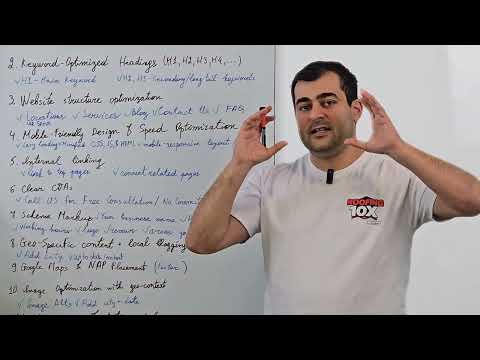Why Your Website Isn’t Ranking—and How to Fix It Fast

Picture this: your website is sleek, the design’s on point, and your products or services are top-notch. But there’s just one tiny hiccup: it’s lost in the vast sea of online content. It’s frustrating, right? You’re not alone! Countless websites find themselves stuck in the dreaded no-man’s land of search engine results pages, far away from the coveted first page.
But here’s the good news: pinpointing why your website isn’t ranking is the first step to soaring visibility. There are common pitfalls that can derail your SEO efforts. Maybe it’s poor keyword targeting or perhaps sluggish site speed is to blame. Even overlooked technical issues can silently undermine all your hard work.
Don’t worry; this is completely fixable. In this post, we’re diving into the top reasons your site might be underperforming and the swift strategies to steer it back on track. Whether you’re a tech newbie or an SEO pro, you’ll find actionable tips to boost your ranking and attract those visitors you deserve. Let’s unravel the mystery and get your site the attention it needs!
Common Reasons Your Website Isn’t Ranking High
Navigating the complex world of SEO can feel like piecing together a giant puzzle. But often, a few key factors could be dragging your site down.
A frequent culprit is improper keyword use. If your content isn’t aligned with what your audience is searching for, your site might miss the mark. Keywords should be relevant and naturally integrated, otherwise search engines might overlook your content.
Then there’s site speed. In our impatient digital age, every second counts. Slow-loading sites not only frustrate users but also send a red flag to search engines, which can impact your ranking.
Technical hiccups, like broken links or missing meta tags, can slip under the radar. These small details, however, are part of the bigger SEO picture. They’re like road signs that guide search engines through your site.
Let’s not forget about quality content. It’s more than just words on a page—it’s about offering value. Content that’s outdated or thin won’t cut it with today’s savvy surfers or search engines.
Lastly, check your mobile-friendliness. With so many browsing on the go, a site that isn’t mobile-responsive could be missing out on a massive chunk of traffic. Each of these elements plays a vital role in boosting your web presence.
Understanding Google Algorithms and Updates
Navigating the world of SEO requires dancing to the tune of Google’s ever-evolving algorithms. These algorithms are essentially the set of rules Google uses to decide which pages deserve to top the search results.
Decoding Algorithm Updates
Google is famously secretive about the nitty-gritty details, but they often drop hints when major updates hit. Each update tweaks the algorithm to serve users better, with aims like reducing spam, improving relevance, and ensuring quality.
Understanding past updates like Panda, Penguin, and more recently, BERT can give insight into what Google values most, such as user experience and quality content. It’s vital to stay alert to announcements on updates to adjust your strategy accordingly.
Staying Up-to-Date
The frequency and impact of these changes demand that website owners remain proactive. Following Google’s official channels or industry thought leaders can provide a heads-up on pending changes.
Adjusting elements of your site in response, such as content quality or link structure, can safeguard against negative impacts. Embracing these updates, rather than fearing them, is key.
Remember, the goal of Google’s algorithm is simple: to deliver the most relevant and helpful results to users. Aligning your strategy with this mission will help your site thrive in the rankings.
Optimizing On-Page SEO Elements
Optimizing on-page SEO elements is like tuning a finely crafted instrument, ensuring harmony in every piece of your content. It’s about making your website both user-friendly and search-engine savvy.
First up, keywords. Integrate them naturally into your headings and content. Don’t just stuff them in; instead, think of them as a way to guide readers and search engines alike.
Crafting Compelling Meta Descriptions
Meta descriptions might seem minor, but they pack a punch. They are your first chance to grab a searcher’s attention. Craft concise, compelling descriptions that make users want to click—and they’re more likely to land you a higher ranking.
Next, focus on title tags. Each page should have a unique, descriptive title that clearly signals what it’s about. Remember, it’s often the first interaction potential visitors have with your content.
Improving Content Readability
Content readability can significantly impact engagement. Use descriptive headings, short paragraphs, and bullet points to make scanning a breeze. It’s all about making your content accessible and inviting.
Don’t overlook internal linking. It helps distribute value across your site and encourages visitors to explore more content, increasing their time on your site.
By refining these on-page elements, you’re setting a solid foundation for driving traffic and improving your site’s rankings.
Enhancing User Experience and Site Speed
Creating an unforgettable user experience is crucial for keeping visitors engaged and navigating smoothly through your site. This, coupled with site speed, forms the backbone of a strong online presence.
Start by ensuring your website is cleanly designed, intuitive, and easy to navigate. Clear calls-to-action and a logical structure will guide visitors effortlessly from page to page, reducing bounce rates and encouraging conversions.
The Importance of Site Speed
Did you know that a delay of just a few seconds in loading time can send potential visitors fleeing? Focus on optimizing site speed by compressing images, leveraging browser caching, and minimizing JavaScript.
Responsive design is key. With more users browsing on mobile devices, a mobile-friendly site isn’t just a nice-to-have—it’s an essential. Make sure your content adjusts seamlessly across all screen sizes.
Keeping it Accessible
Don’t forget accessibility. A website accessible to everyone, including those with disabilities, enhances usability and broadens your audience. Use alt text for images, ensure easy navigation, and offer text transcripts for audio content.
By focusing on these elements, you not only enhance user satisfaction but also signal to search engines that your site is optimized, leading to better rankings and more substantial web traffic.
Utilizing Quality Backlinks and Anchor Text
Backlinks are the backbone of a robust SEO strategy, acting like votes of confidence from other sites. High-quality backlinks tell search engines that your site is trustworthy and authoritative.
Focus on earning links from reputable websites. These should be from sources relevant to your niche and industry to really pack a punch. Think guest posts, partnerships, or being mentioned in industry blogs and news sites.
Anchor text plays a pivotal role in the effectiveness of backlinks. It should be relevant and descriptive, providing a clear idea of what users can expect when they click. Avoid generic phrases like "click here" that do little to enhance SEO.
Diversity is key with anchor text. Mix things up with exact match keywords, branded terms, and naturally conversational phrases to keep your link profile looking organic and varied.
Remember, the focus should be on quality over quantity. One link from a high-authority site can be far more beneficial than dozens from less reputable ones. By strategically building your backlink profile, you improve your site’s authority and increase its chances of climbing the search engine rankings.

Implementing Effective Keyword Strategies
Crafting an effective keyword strategy is the cornerstone of driving relevant traffic to your website. It starts with in-depth research to uncover the terms your target audience is searching for.
Identify a mix of short-tail and long-tail keywords. Short-tail keywords are broader and often high-competition, while long-tail keywords allow you to target more specific queries, often with less competition and greater conversion potential.
Integrate these keywords naturally throughout your content. They should appear in strategic locations like titles, headers, and the first paragraph, but always read smoothly. Forced keywords disrupt the flow and can deter both readers and search engines.
Stay flexible. The digital landscape is always evolving, and so should your keyword strategy. Regularly review and update your keywords to align with current trends and search behavior. Tools like Google Keyword Planner can offer insights into evolving user interests.
Monitoring performance is crucial. Keep an eye on which keywords are driving traffic and conversions so you can continuously refine your list. By leveraging a dynamic keyword strategy, you ensure your content reaches—and resonates with—the right audience at the right time.
Conclusion: Taking Action to Improve Your Website Ranking
Improving your website’s ranking isn’t an overnight process, but by taking deliberate, strategic actions, you’ll see tangible results. We’ve covered a lot of ground—from the fundamentals of on-page SEO to the intricacies of backlink strategies, and it’s clear that each element plays a vital role in your search engine performance.
Begin by auditing your current SEO practices to identify areas where improvements can be made. Focus on refining your keyword strategy and ensure your content is rich in value, addressing the needs and interests of your audience. Remember, quality content naturally attracts attention and encourages backlinks from reputable sites.
Pay particular attention to user experience and site speed. Remember, a fast, responsive site is not just favored by search engines, but greatly appreciated by users—it keeps them coming back for more.
Don’t ignore the nuances of Google’s algorithm updates. Keeping your ear to the ground for changes ensures your strategies remain effective and relevant. Continually adapt as necessary, using insights and data to guide your decisions.
Lastly, keep learning and experimenting. SEO is an ever-evolving field, and staying informed will keep you ahead of the curve. Engage with the latest SEO news and trends to ensure your tactics are always enhancing your website’s visibility.
In summary, consistent, thoughtful efforts tailored to your website’s strengths and weaknesses will gradually elevate your rankings. Take action on these insights, and watch your site transform from a hidden gem to a star performer in the digital landscape.



